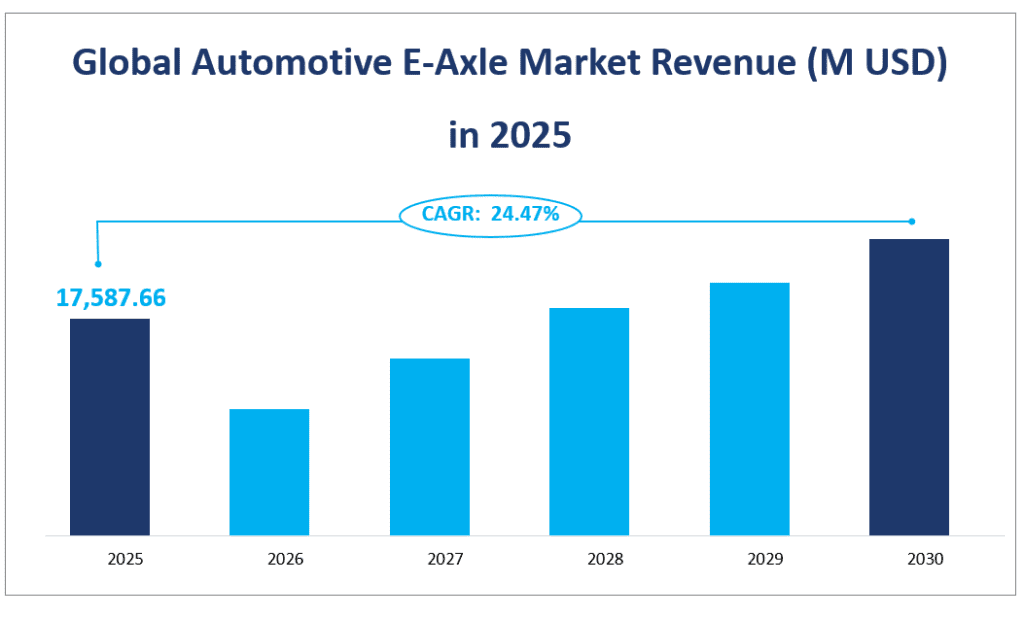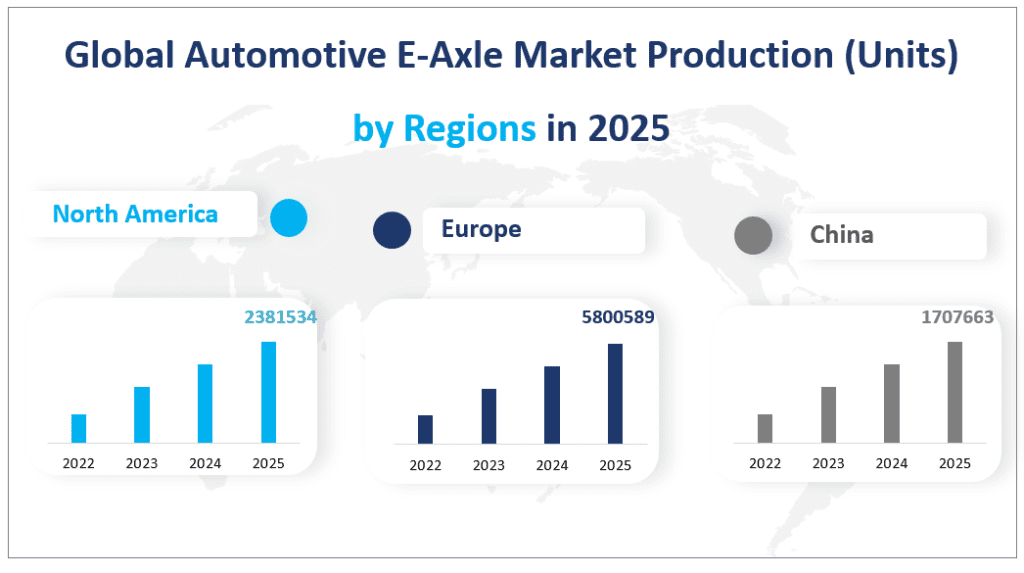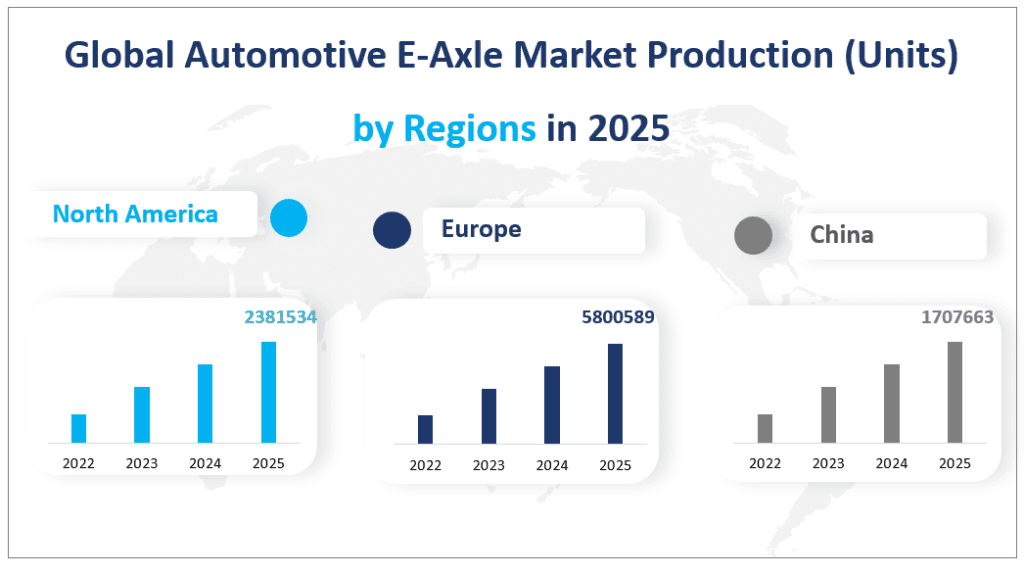1. Global Automotive E-Axle Market Overview
The global automotive E-Axle market revenue is projected to reach $17,587.66 million, with a CAGR of 24.47% from 2025 to 2030. This growth is fueled by the increasing adoption of electric vehicles (EVs) and hybrid vehicles, which rely heavily on advanced electric drive systems like the E-Axle.
An E-Axle, or electric axle, is a compact and integrated electric drive solution that combines the electric motor, power electronics, and gearbox into a single unit. This system directly powers the vehicle’s axles, providing a highly efficient and lightweight alternative to traditional mechanical drivetrains. The E-Axle is a critical component in the electrification of vehicles, enabling faster acceleration, higher efficiency, and reduced energy waste. It is designed to be lightweight and compact, making it ideal for both front-wheel drive (FWD), rear-wheel drive (RWD), and all-wheel drive (AWD) configurations.
Global Automotive E-Axle Market Revenue (M USD) in 2025


2. Driving Factors of the Automotive E-Axle Market
Firstly, the increasing demand for electric and hybrid vehicles is a major driver. Governments around the world are implementing stricter emission regulations to combat climate change, pushing automakers to develop and produce more electric vehicles. This, in turn, increases the demand for E-Axles, which are essential components in these vehicles.
Secondly, technological advancements in electric drive systems are making E-Axles more efficient and cost-effective. Innovations in motor design, power electronics, and materials science are enabling manufacturers to produce E-Axles that are lighter, more powerful, and more reliable. These advancements are not only improving the performance of electric vehicles but also reducing their overall cost, making them more accessible to consumers.
Thirdly, the global push for sustainable transportation is driving the adoption of electric vehicles. Consumers are becoming increasingly aware of the environmental impact of traditional internal combustion engines and are opting for cleaner, greener alternatives. This shift in consumer behavior is driving the demand for electric vehicles and, by extension, the demand for E-Axles.
3. Limiting Factors of the Automotive E-Axle Market
Despite the significant growth potential, the automotive E-Axle market faces several challenges. One of the primary limiting factors is the high cost of E-Axle systems. The advanced technology and materials used in E-Axles make them expensive to produce, which can limit their adoption in cost-sensitive markets. Additionally, the high cost of raw materials, such as rare earth metals and advanced composites, can further increase production costs.
Another challenge is the intense competition in the market. The automotive E-Axle market is highly competitive, with several major players vying for market share. Companies like Melrose Industries PLC (GKN), Dana Incorporated, and Continental AG dominate the market, making it difficult for new entrants to gain a foothold. This competition can lead to price wars and reduced profit margins for manufacturers.
4. Global Automotive E-Axle Market Segment
Product Types
The Forward Wheel Drive (FWD) type is projected to hold the largest market share in 2025 with a market revenue of $9437.25 million in 2025. This dominance is attributed to the widespread adoption of FWD systems in electric vehicles (EVs) and hybrid vehicles, which are increasingly popular due to their efficiency and cost-effectiveness.
The All-Wheel Drive (AWD) type is expected to exhibit the fastest growth rate, with a market size of $2538.15 million in 2025. This rapid growth is driven by the increasing demand for high-performance electric vehicles that require advanced traction and stability, particularly in regions with challenging driving conditions. AWD systems provide superior handling and safety, making them an attractive option for premium and luxury electric vehicles.
Applications of the Automotive E-Axle Market
Electric Vehicles (EVs) are projected to hold the largest market share in 2025 with a market revenue of $17554.00 million in 2025. The dominance of EVs is driven by the global push for sustainable transportation, stringent emission regulations, and significant advancements in battery technology. Governments around the world are incentivizing the adoption of EVs through subsidies and tax benefits, further accelerating market growth.
Hydrogen Cars are expected to exhibit the fastest growth rate, with a market size of $33.66 million in 2025. Although the market size is relatively small compared to EVs, the growth rate is significant due to the increasing interest in hydrogen fuel cell technology as a zero-emission alternative. Hydrogen cars offer the potential for longer driving ranges and faster refueling times, making them an attractive option for future transportation needs. However, the infrastructure for hydrogen fueling stations is still in its nascent stage, which limits the widespread adoption of hydrogen cars in the near term.
The global automotive E-Axle market is poised for significant growth, driven by the increasing demand for electric and hybrid vehicles. Among the product types, forward-wheel drive (FWD) systems are projected to hold the largest market share in 2025, while All-Wheel Drive (AWD) systems are expected to grow at the fastest rate. In terms of applications, Electric Vehicles (EVs) dominate the market, accounting for nearly the entire market revenue, with Hydrogen Cars showing the fastest growth rate. As the world transitions towards sustainable transportation, the automotive E-Axle market will continue to evolve, driven by technological advancements and shifting consumer preferences.
Market Revenue by Segment
| Market Revenue (M USD) in 2025 | ||
| By Type | Forward Wheel Drive (FWD) | 9437.25 |
| Rear Wheel Drive (RWD) | 5612.26 | |
| All-wheel Drive (AWD) | 2538.15 | |
| By Application | EV Car | 17554.00 |
| Hydrogen Car | 33.66 |
5. Regional Automotive E-Axle Market
The global automotive E-Axle market is experiencing significant growth, driven by the increasing demand for electric and hybrid vehicles. The automotive E-Axle market is characterized by robust production growth across several key regions. By 2025, the production landscape is expected to be dominated by Europe, China, and North America, with each region contributing significantly to the global output.
Europe is projected to be the largest regional market by production, with an estimated output of 5800589 units in 2025. This dominance is attributed to the region’s strong automotive industry, stringent emission regulations, and significant investments in electric vehicle (EV) technology.
China is expected to produce 1707663 units in 2025, making it the second-largest regional market. China’s rapid adoption of electric vehicles, supported by government incentives and a growing middle class, has driven significant growth in E-Axle production.
North America is projected to produce 2381534 units in 2025. The region’s production growth is driven by the increasing demand for electric vehicles and the presence of major automotive manufacturers that are investing heavily in electrification.
While Europe leads in terms of production volume, the fastest-growing region is China. This rapid growth is driven by the Chinese government’s aggressive push for electric vehicle adoption, significant investments in battery technology, and the expansion of domestic automotive manufacturers into the global market.
Global Automotive E-Axle Market Production (Units) by Regions in 2025


6. Top 3 Companies in the Automotive E-Axle Market
Company Introduction and Business Overview:
Melrose Industries PLC, through its subsidiary GKN, is a leading global supplier of automotive components and systems. Established in 1902, GKN specializes in driveline systems, vehicle chassis assemblies, and power take-off shafts. The company operates primarily in Europe but has a global sales network.
Products Offered:
GKN offers a range of E-Axle products, including the eTwinsterX, an integrated electric drive unit designed for hybrid and fully electric vehicles. The eTwinsterX features a two-speed transmission, providing a balance between acceleration and top speed.
Company Introduction and Business Overview:
Dana Incorporated, established in 1904, is a global leader in the design and manufacture of efficient propulsion and energy management solutions. The company operates primarily in the United States and Europe, serving a wide range of mobility markets.
Products Offered:
Dana offers Spicer® axles, which are engineered for high torque density and reliability. The company’s eS9000r e-Axle is a notable product, designed for medium-duty electric vehicles. Dana’s solutions are known for their compact design and high performance.
Company Introduction and Business Overview:
Continental AG, founded in 1871, is a major automotive supplier with a diverse product portfolio. The company operates primarily in Europe and offers a wide range of automotive parts, including tires, braking systems, and transmission products.
Products Offered:
Continental AG’s E-Axle product, the high voltage axle drive, is a highly integrated electric drive system. It features a permanent magnet synchronous motor, an inverter, and a reducer, designed for high-volume electric vehicles. The system is compact, lightweight, and offers high efficiency.
Major Players
| Company Name | Plants Distribution | Sales Region |
| Melrose Industries PLC (GKN) | Mainly in Europe | Worldwide |
| Dana Incorporated | Mainly in the USA and Europe | Worldwide |
| Continental AG | Mainly in Europe | Worldwide |
| Borgwarner | Mainly in the USA, Europe, and Asia | Worldwide |
| ZF Friedrichshafen AG | Mainly in Europe | Worldwide |
| Schaeffler AG | Mainly in Europe | Mainly in North America, Europe, and Asia Pacific |
| Robert Bosch GmbH | Mainly in Europe | Worldwide |
| Nidec Corporation | Mainly in Asia and Europe | Mainly in Asia Pacific, Europe, and North America |
| Magna International | Mainly in North America | Mainly in North America and Europe |
| Linamar Corporation | Mainly in North America | Mainly in North America and Europe |
1 Automotive E-Axle Introduction and Market Overview
1.1 Objectives of the Study
1.2 Overview of Automotive E-Axle
1.3 Automotive E-Axle Market Scope and Market Size Estimation
1.3.1 Market Concentration Ratio and Market Maturity Analysis
1.3.2 Global Automotive E-Axle Revenue and Growth Rate from 2016-2026
1.4 Market Segmentation
1.4.1 Types of Automotive E-Axle
1.4.2 Applications of Automotive E-Axle
1.4.3 Research Regions
1.5 Market Dynamics
1.5.1 Automotive E-Axle Industry Trends
1.5.2 Automotive E-Axle Drivers
1.5.3 Automotive E-Axle Market Challenges
1.5.4 Automotive E-Axle Market Restraints
1.6 Industry News and Policies by Regions
1.6.1 Industry News
1.6.2 Industry Policies
1.7 Mergers & Acquisitions, Expansion Plans
1.8 Automotive E-Axle Industry Development Trends under COVID-19 Outbreak
1.8.1 Global COVID-19 Status Overview
1.8.2 Influence of COVID-19 Outbreak on Automotive E-Axle Industry Development
2 Industry Chain Analysis
2.1 Upstream Raw Material Supply and Demand Analysis
2.1.1 Global Automotive E-Axle Major Upstream Raw Material and Suppliers
2.1.2 Raw Material Source Analysis
2.2 Major Players of Automotive E-Axle
2.2.1 Major Players Manufacturing Base of Automotive E-Axle in 2020
2.2.2 Major Players Market Distribution in 2020
2.3 Automotive E-Axle Manufacturing Cost Structure Analysis
2.3.1 Production Process Analysis
2.3.2 Manufacturing Cost Structure of Automotive E-Axle
2.3.3 Labor Cost of Automotive E-Axle
2.4 Market Channel Analysis of Automotive E-Axle
2.5 Major Down Stream Customers by Application
3 Global Automotive E-Axle Market, by Type
3.1 Global Automotive E-Axle Revenue and Market Share by Type (2016-2021)
3.2 Global Automotive E-Axle Sales and Market Share by Type (2016-2021)
3.3 Global Automotive E-Axle Revenue and Growth Rate by Type (2016-2021)
3.3.1 Global Automotive E-Axle Revenue and Growth Rate of Forward Wheel Drive (FWD)
3.3.2 Global Automotive E-Axle Revenue and Growth Rate of Rear Wheel Drive (RWD)
3.3.3 Global Automotive E-Axle Revenue and Growth Rate of All-wheel Drive (AWD)
3.4 Global Automotive E-Axle Price Analysis by Type (2016-2021)
4 Automotive E-Axle Market, by Application
4.1 Downstream Market Overview
4.2 Global Automotive E-Axle Consumption and Market Share by Application (2016-2021)
4.3 Global Automotive E-Axle Consumption and Growth Rate by Application (2016-2021)
4.3.1 Global Automotive E-Axle Consumption and Growth Rate of EV Car (2016-2021)
4.3.2 Global Automotive E-Axle Consumption and Growth Rate of Hydrogen Car (2016-2021)
5 Global Automotive E-Axle Consumption, Revenue (M USD) by Region (2016-2021)
5.1 Global Automotive E-Axle Revenue and Market Share by Region (2016-2021)
5.2 Global Automotive E-Axle Consumption and Market Share by Region (2016-2021)
5.3 Global Automotive E-Axle Consumption, Revenue, Price and Gross Margin (2016-2021)
5.4 North America Automotive E-Axle Consumption, Revenue, Price and Gross Margin (2016-2021)
5.4.1 North America Automotive E-Axle Market Under COVID-19
5.4.2 North America Automotive E-Axle SWOT Analysis
5.5 Europe Automotive E-Axle Consumption, Revenue, Price and Gross Margin (2016-2021)
5.5.1 Europe Automotive E-Axle Market Under COVID-19
5.5.2 Europe Automotive E-Axle SWOT Analysis
5.6 China Automotive E-Axle Consumption, Revenue, Price and Gross Margin (2016-2021)
5.6.1 China Automotive E-Axle Market Under COVID-19
5.6.2 China Automotive E-Axle SWOT Analysis
5.7 Japan Automotive E-Axle Consumption, Revenue, Price and Gross Margin (2016-2021)
5.7.1 Japan Automotive E-Axle Market Under COVID-19
5.7.2 Japan Automotive E-Axle SWOT Analysis
5.8 Middle East and Africa Automotive E-Axle Consumption, Revenue, Price and Gross Margin (2016-2021)
5.8.1 Middle East and Africa Automotive E-Axle Market Under COVID-19
5.8.2 Middle East and Africa Automotive E-Axle SWOT Analysis
5.9 India Automotive E-Axle Consumption, Revenue, Price and Gross Margin (2016-2021)
5.9.1 India Automotive E-Axle Market Under COVID-19
5.9.2 India Automotive E-Axle SWOT Analysis
5.10 South America Automotive E-Axle Consumption, Revenue, Price and Gross Margin (2016-2021)
5.10.1 South America Automotive E-Axle Market Under COVID-19
5.10.2 South America Automotive E-Axle SWOT Analysis
5.11 South Korea Automotive E-Axle Consumption, Revenue, Price and Gross Margin (2016-2021)
5.11.1 South Korea Automotive E-Axle Market Under COVID-19
5.11.2 South Korea Automotive E-Axle SWOT Analysis
5.12 Southeast Asia Automotive E-Axle Consumption, Revenue, Price and Gross Margin (2016-2021)
5.12.1 Southeast Asia Automotive E-Axle Market Under COVID-19
5.12.2 Southeast Asia Automotive E-Axle SWOT Analysis
6 Global Automotive E-Axle Production by Top Regions (2016-2021)
6.1 Global Automotive E-Axle Production by Top Regions (2016-2021)
6.2 North America Automotive E-Axle Production and Growth Rate
6.3 Europe Automotive E-Axle Production and Growth Rate
6.4 China Automotive E-Axle Production and Growth Rate
6.5 Japan Automotive E-Axle Production and Growth Rate
7 Global Automotive E-Axle Consumption by Regions (2016-2021)
7.1 Global Automotive E-Axle Consumption by Regions (2016-2021)
7.2 North America Automotive E-Axle Consumption and Growth Rate
7.3 Europe Automotive E-Axle Consumption and Growth Rate
7.4 China Automotive E-Axle Consumption and Growth Rate
7.5 Japan Automotive E-Axle Consumption and Growth Rate
7.6 Middle East & Africa Automotive E-Axle Consumption and Growth Rate
7.7 India Automotive E-Axle Consumption and Growth Rate
7.8 South America Automotive E-Axle Consumption and Growth Rate
7.9 South Korea Automotive E-Axle Consumption and Growth Rate
7.10 Southeast Asia Automotive E-Axle Consumption and Growth Rate
8 Competitive Landscape
8.1 Competitive Profile
8.2 Melrose Industries PLC (GKN)
8.2.1 Company Profiles
8.2.2 Automotive E-Axle Product Profiles, Application and Specification
8.2.3 Melrose Industries PLC (GKN) Sales, Value, Price, Gross Margin 2016-2021
8.2.4 Company Recent Development
8.2.5 Strategies for Company to Deal with the Impact of COVID-19
8.3 Dana Incorporated
8.3.1 Company Profiles
8.3.2 Automotive E-Axle Product Profiles, Application and Specification
8.3.3 Dana Incorporated Sales, Value, Price, Gross Margin 2016-2021
8.3.4 Company Recent Development
8.3.5 Strategies for Company to Deal with the Impact of COVID-19
8.4 Continental AG
8.4.1 Company Profiles
8.4.2 Automotive E-Axle Product Profiles, Application and Specification
8.4.3 Continental AG Sales, Value, Price, Gross Margin 2016-2021
8.4.4 Company Recent Development
8.4.5 Strategies for Company to Deal with the Impact of COVID-19
8.5 Borgwarner
8.5.1 Company Profiles
8.5.2 Automotive E-Axle Product Profiles, Application and Specification
8.5.3 Borgwarner Sales, Value, Price, Gross Margin 2016-2021
8.5.4 Company Recent Development
8.5.5 Strategies for Company to Deal with the Impact of COVID-19
8.6 ZF Friedrichshafen AG
8.6.1 Company Profiles
8.6.2 Automotive E-Axle Product Profiles, Application and Specification
8.6.3 ZF Friedrichshafen AG Sales, Value, Price, Gross Margin 2016-2021
8.6.4 Company Recent Development
8.6.5 Strategies for Company to Deal with the Impact of COVID-19
8.7 Schaeffler AG
8.7.1 Company Profiles
8.7.2 Automotive E-Axle Product Profiles, Application and Specification
8.7.3 Schaeffler AG Sales, Value, Price, Gross Margin 2016-2021
8.7.4 Company Recent Development
8.7.5 Strategies for Company to Deal with the Impact of COVID-19
8.8 Robert Bosch GmbH
8.8.1 Company Profiles
8.8.2 Automotive E-Axle Product Profiles, Application and Specification
8.8.3 Robert Bosch GmbH Sales, Value, Price, Gross Margin 2016-2021
8.8.4 Company Recent Development
8.8.5 Strategies for Company to Deal with the Impact of COVID-19
8.9 Nidec Corporation
8.9.1 Company Profiles
8.9.2 Automotive E-Axle Product Profiles, Application and Specification
8.9.3 Nidec Corporation Sales, Value, Price, Gross Margin 2016-2021
8.9.4 Company Recent Development
8.10 Magna International
8.10.1 Company Profiles
8.10.2 Automotive E-Axle Product Profiles, Application and Specification
8.10.3 Magna International Sales, Value, Price, Gross Margin 2016-2021
8.10.4 Company Recent Development
8.11 Linamar Corporation
8.11.1 Company Profiles
8.11.2 Automotive E-Axle Product Profiles, Application and Specification
8.11.3 Linamar Corporation Sales, Value, Price, Gross Margin 2016-2021
8.11.4 Company Recent Development
8.11.5 Strategies for Company to Deal with the Impact of COVID-19
9 Global Automotive E-Axle Market Analysis and Forecast by Type and Application
9.1 Global Automotive E-Axle Market Revenue & Volume Forecast, by Type (2021-2026)
9.1.1 Forward Wheel Drive (FWD) Market Revenue and Volume Forecast (2021-2026)
9.1.2 Rear Wheel Drive (RWD) Market Revenue and Volume Forecast (2021-2026)
9.1.3 All-wheel Drive (AWD) Market Revenue and Volume Forecast (2021-2026)
9.2 Global Automotive E-Axle Market Revenue & Volume Forecast, by Application (2021-2026)
9.2.1 EV Car Market Revenue and Volume Forecast (2021-2026)
9.2.2 Hydrogen Car Market Revenue and Volume Forecast (2021-2026)
10 Automotive E-Axle Market Supply and Demand Forecast by Region
10.1 Global Market Production Forecast (2021-2026)
10.2 Automotive E-Axle Market Consumption Forecast by Region
10.3 Explanation of Market Size Trends by Region
10.4 Automotive E-Axle Market Trends Analysis
11 New Project Feasibility Analysis
11.1 Industry Barriers and New Entrants SWOT Analysis
12 Research Finding and Conclusion
13 Appendix
13.1 Methodology
13.2 Research Data Source
13.2.1 Secondary Data
13.2.2 Primary Data
13.2.3 Market Size Estimation
13.2.4 Legal Disclaimer
